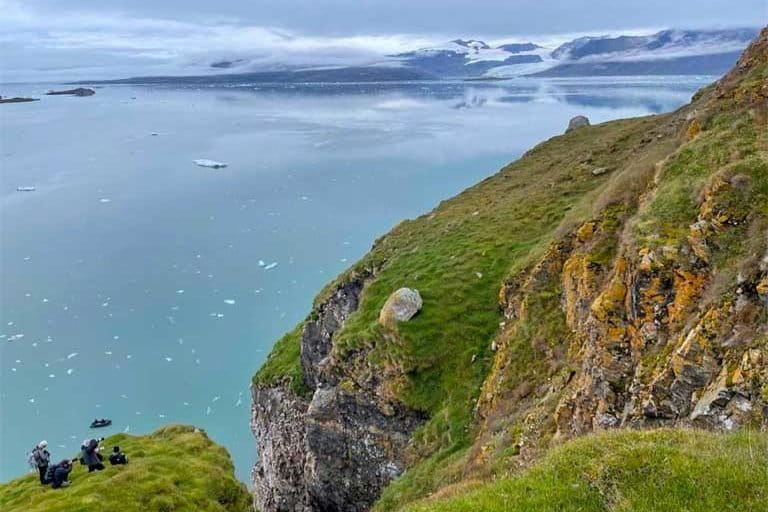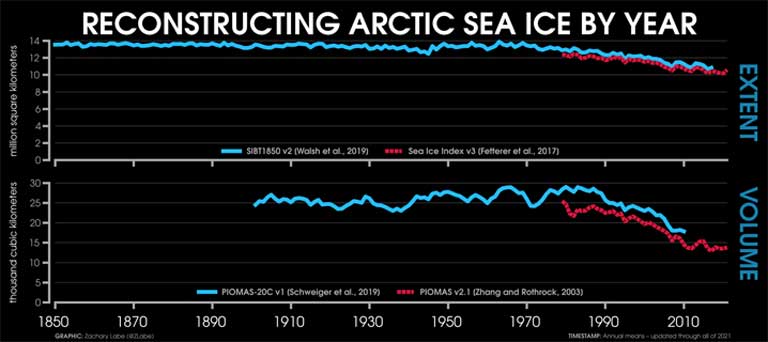- Arctic sea ice extent shrank to its summertime minimum this week — tied with 2017 and 2018 for the 10th lowest ever recorded. However, the last 16 consecutive years have seen the least ice extent since the satellite record began. Polar sea ice extent, thickness and volume all continue trending steeply downward.
- Arctic air temperatures were high this summer, with parts of the region seeing unprecedented heating. Greenland saw air temperatures up to 36° F. above normal in September. Canada’s Northwest Territories saw record highs, hitting the 90s in July. Sea temperatures also remained very high in many parts of the Arctic Ocean.
- Scientists continue to be concerned as climate change warms the far North nearly four times faster than the rest of the planet, sparking concern over how polar warming may be impacting the atmospheric jet stream, intensifying disastrous extreme weather events worldwide, including heat waves, droughts and storms.
- While a mostly ice-free Arctic could occur as early as 2040, scientists emphasize that it needn’t happen. If humanity chooses to act now to drastically reduce greenhouse gas emissions, downward sea ice extent and volume trends could potentially be reversed.
In August, I traveled aboard the icebreaker Kinfish to the Svalbard archipelago, north of the Arctic Circle. Invited to the bridge as we cruised fjords near the 80th parallel, I was transfixed by towering blue glacier walls, but was confused by the map displayed on one of the ship’s screens. It showed our vessel sailing across a non-navigable frozen sheet.
When I shared this story with Walt Meier, a senior research scientist at the National Snow and Ice Data Center, he didn’t seem surprised. “Things change fast there nowadays,” he said. So quickly, even polar ice mapping can’t keep pace.
The 2022 spring/summer Arctic melt season, when the sun never sets and sea ice retreats, has now ended as the days quickly shorten, with the Far North heading back to full winter darkness. It wasn’t a record-breaking or news-making year for low ice extent — it ranked tenth, tying with 2017 and 2018 — but it has been yet another consequential melt season.

The last 16 consecutive years have been the lowest since 1979 when satellite tracking began, with the all-time low in 2012, says Zachary Labe, a postdoctoral researcher at Princeton University, and at the National Oceanic and Atmospheric Administration’s (NOAA) Geophysical Fluid Dynamics Laboratory. Overall, climate change is warming the Arctic nearly four times faster than the rest of the planet. But melt is not equal across the Arctic. The biggest overall factors impacting sea ice are air and sea temperatures, with winds and storms sometimes adding collateral damage.
Across much of the planet, it was a burning hot summer, with record-breaking heatwaves from Hong Kong and India to much of Europe, and the U.S. — and on top of the world as well. Air temperatures over “a good chunk of the Arctic” exceeded the 30-year average, says Meier. Unprecedented heat in Greenland during September, up to 36° degrees F. (20 degrees C.) above normal, helped slightly prolong the melt season: the average sea ice nadir is September 14; it came this year on September 18.
Back in July, Canada’s Northwest Territories broiled under extreme temperatures, which soared into the 90s, breaking all-time highs. That record warmth created countless melt ponds on Beaufort Sea ice, closely watched by scientists because it has retained substantial amounts of “old” thick ice, which is more resistant to melt. Those melt ponds erode ice from above.
Newly published research in Scientific Reports found air temperatures in the Northern Barents Sea region (north of Norway and Russia) from 1981-2020 have been “exceptional,” even for the Arctic — with temperatures there increasing at 5 to 7 times the global rate.Sea temperatures can be particularly damaging to annual extent. An ice cube in warm water melts faster than ice floating in cold water in a warm room, explains Meier.
Sea ice began disappearing exceptionally early this year in the Beaufort Sea, north of Canada and Alaska, the neighboring Chukchi Sea, and Siberia’s Laptev Sea — partly due to warmer ocean temperatures.


This melting trend generated localized feedback loops. Ice reflects at least 50% of solar radiation back into space. But ice-free blue ocean absorbs some 90% of the sun’s heat, warming the sea and melting more ice, explains Labe. August sea temperatures were among the hottest ever in the Beaufort Sea. A recent study reported that during the 21st century, the upper mile of Arctic Ocean waters have warmed at 2.3 times the global mean.
Ocean currents streaming into the Arctic from the south also raise water temperatures. Warm inflow from the Bering Strait, the Pacific and the Atlantic can delay fall refreezing or speed ice loss in the spring and summer.
Wind and storms, too, play a role, breaking up and spreading ice. If floes are pushed into wide open waters, they likely melt. But on the north coast of Greenland and along the Canadian Archipelago where Arctic winds push the ice up against land, it piles up, forming thick ice that’s likely to withstand summer warmth.
Researchers have pieced together sea ice information going back to the 1800s using records from whaling ships, marine data and diaries. That data has revealed year-to-year weather variability, what Labe calls “just a squiggly line that goes up and down … until you hit the 1980s, and then it drops.” The long-term trend, he says, “shows a clear, massive change ongoing in this region.”
The overall downward trend in minimum Arctic sea ice extent from 1979 to 2022 has been 12.6% per decade relative to the 1981 to 2010 average — some 30,300 square miles (78,500 sq. kms.) per year, an area the size of Austria or South Carolina.

On thin ice…
Since about 2005, disappearing Arctic Sea ice — and especially its lowest September extent — has dominated the news. But there’s been far less attention placed on another critical factor: ice thickness, which has declined dramatically since the mid-1980s, says Meier. Back then multiyear ice covered nearly two-thirds of Arctic seas. Today, about one-third of multiyear ice remains.
The very oldest ice, which survives multiple summer melts and grows thicker during the frigid, dark winters, is solid — perhaps 12 feet thick in places, and enduring — but it has virtually disappeared, notes Meier. “It’s now about 5% of the total ice cover, primarily holding out along the north coast of Greenland and the Canadian Archipelago.”
First-year ice now dominates and it’s far thinner and more fragile, Labe says, “So, if you get extreme temperatures or large storm systems up there, this ice is more easily broken up, blown around, and melted.”
He noted a unique and worrying occurrence this year as far north as the 88th parallel, just 185 miles from the North Pole. In the past, this was an area frozen year-round in thick pack ice. In recent years, satellite observations have revealed some patches of looser, less compact ice, but this summer, “there were sizeable openings, areas up to 38 by 38 square miles, with very little ice, if any at all,” he says. “It was pretty remarkable, and indicates a younger and a thinner ice cover, more broken up.”
Labe’s analysis puts this in perspective. “The story essentially is that there has been thinning ice nearly every single month of the year across almost the entire Arctic over the last four decades.” Over the last 60 years, sea ice thickness declined by about six feet, about 66%.

What starts in the Arctic…
Earth’s climate system is interconnected, and the rapidly warming Arctic Ocean — the size of the lower 48 U.S. states — impacts the rest of the planet, say scientists.
Several studies have indicated, for example, that the Arctic’s warming climate may be altering the location and speed with which the atmospheric jet stream circles the Northern Hemisphere — meandering deeply south, or holding sluggishly almost in place, at times, possibly contributing to record breaking weather patterns and more extreme weather. The polar vortex, for example, which mostly spun fast and tight around the polar region in the past, has become more wobbly and unstable, occasionally dropping down over the U.S., Europe or Asia, blasting them with bone-chilling cold.
Overall, says Meier, “the Arctic’s response to greenhouse gases [in terms of sea ice] is definitely a strong downward trend, and even faster than what the models have projected. The Arctic is a very different environment than it used to be, and that’s very clear to anyone that’s lived there or studied [the polar region].”

There’s ongoing conjecture about when the Arctic Ocean will see its first largely ice-free summer conditions. Early reports from the U.N. Intergovernmental Panel on Climate Change predicted this might happen by 2100. Those estimates have now been reduced to mid-century, perhaps by 2040.
But that particular landmark event may be more important to the media than to scientists, Labe says. “It’s symbolic for climate science when we become ice-free. But we’re already seeing impacts to the climate system, and the more ice we lose, the larger those impacts will become.”
The loss of sea ice, and the speed with which it happens, “depends on the emissions trajectory that we take over these next 10, 20, 30 years,” Meier says. Human actions can make a positive difference.
Labe agrees. “Climate models show that by reducing greenhouse gas emissions, we can reduce the chance of an ice-free Arctic. I like to point out that climate models show that we are not locked into an ice-free future.”
Banner image: Open ocean with some floating ice in August 2022 off of Svarlbard in the Arctic. Image by Sharon Guynup.

FEEDBACK: Use this form to send a message to the author of this post. If you want to post a public comment, you can do that at the bottom of the page.
